= Echinopsis werdermanniana (Backeb.) H.Friedrich & G.D.Rowley
I.O.S. Bull. 3(3): 99 (1974)
Accepted Scientific Name: Echinopsis terscheckii (J.Parm. ex Pfeiff.) H.Friedrich & G.D.Rowley
I.O.S. Bull. 3(3): 98 (1974)
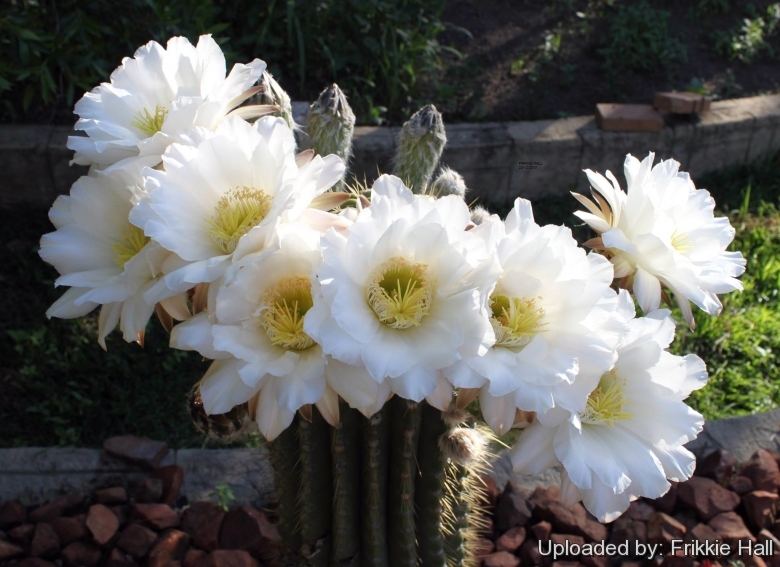
Trichocereus werdermannianus (Echinopsis werdermanniana) Photo by: Frikkie Hall
Origin and Habitat: Bolivia, typus location is in the Charcoma Valley, east of Tupiza but also present around Potosi. It is very likely that Trichocereus taquimbalensisSN|8750]]SN|8725]] from the region around those aforementioned locations is actually Trichocereus werdermannianusSN|8725]]SN|8750]].
Habitat and ecology: Echinopsis werdermannianaSN|8749]]SN|8749]] grows on hillsides at about 2600-3000 metres elevation together with Oreocereus celsianusSN|5952]]SN|5952]].
Synonyms:
See all synonyms of Echinopsis terscheckii
back
Accepted name in llifle Database:Echinopsis terscheckii (J.Parm. ex Pfeiff.) H.Friedrich & G.D.RowleyI.O.S. Bull. 3(3): 98 (1974)Synonymy: 9
back
Common Names include:
SPANISH (Español): Cardon Grande, Cardon
Description: Echinopsis werdermannianaSN|7374]]SN|8749]] (Backeberg) Friedrich & Rowley (Trichocereus werdermannianusSN|8722]]SN|8750]] Backeberg) is a large, handsome cactus that reaches 5(-8) m in height with a thick trunk to 60 cm in diameter and resembles Echinopsis atacamensisSN|8749]]SN|7374]] in habit, but is more massive and has comparatively few spines. Its fruits should be tasty.
Derivation of specific name: This member of the Cactaceae family was given this name in honour of Prof. Dr. Erich Werdermann.
Stem: Trunks to 1 m high and 65 cm in diameter, branches arising apically, more or less erect up to 15 cm thick very dark green.
Ribs: About 10, later increasing to 14 or more, 2 cm high.
Areoles: 2.5 cm apart.
Spines: The spines looks like a mix of Trichocereus taquimbalensisSN|8725]]SN|8725]] and Trichocereus terscheckiiSN|8750]]SN|8746]], hardly distinguishable as radial and central, between 5 and 10 cm long, straw-coloured, yellowish brown or horn coloured.
Central spine: 1 (or 2), robust, awl-like.
Radial spines: 8.
Flowers: Usually emerging from the top of the plant rather than at lower regions of stems. When numerous forming a ring around the apex. White about 20-22 cm long.
Fruits: Spherical 3.5-4 cm in diameter with many white or black hairs.
Seeds: 1.3-1,4 mm large, cap-like, rough.
Taxonomic notes: Trichocereus werdermannianusSN|8746]]SN|8750]] Backeberg is an old name that is no longer accepted (nomen nudum... not a valid species). Plants corresponding the original type that Backeberg once called Trichocereus werdermannianusSN|8746]]SN|8750]] are approximately intermediate between Trichocereus taquimbalensisSN|8725]]SN|8725]] and Trichocereus terscheckiiSN|8750]]SN|8746]] and now generally included within (as a synonym of) Trichocereus terscheckiiSN|8750]]SN|8746]], suggesting that there is not really a fundamental difference between the two. Regrettably most plants in cultivation under this name seldom match up to the original description, being usually raised from commercial seed which has often been wrongly identified. The plants labeled Trichocereus werdermannianusSN|8746]]SN|8750]] are usually misidentified Trichocereus taquimbalensisSN|8725]]SN|8725]] or Trichocereus tacaquirensisSN|8750]]SN|8722]].
Subspecies, varieties, forms and cultivars of plants belonging to the Echinopsis terscheckii group
 Echinopsis terscheckii (J.Parm. ex Pfeiff.) H.Friedrich & G.D.Rowley: is a huge treelike cactus speciesat first columnar, and usually in age with numerous large arms, 10 to 12 meters high. Distribution: Argentina (Catamarca, Salta, Jujuy, La Rioja, San Juan and Tucumán provinces) and Bolivia (Tarija).
Echinopsis terscheckii (J.Parm. ex Pfeiff.) H.Friedrich & G.D.Rowley: is a huge treelike cactus speciesat first columnar, and usually in age with numerous large arms, 10 to 12 meters high. Distribution: Argentina (Catamarca, Salta, Jujuy, La Rioja, San Juan and Tucumán provinces) and Bolivia (Tarija). Echinopsis terscheckii f. variegata hort.: variegated form. Stems have sectors, patches or stripes with distinct shades of yellow.
Echinopsis terscheckii f. variegata hort.: variegated form. Stems have sectors, patches or stripes with distinct shades of yellow.  Echinopsis werdermanniana (Backeb.) H.Friedrich & G.D.Rowley: has 10-14 ribs, 8 radial and 1(-2) central spines, flowers nearly apical up to 22 cm long. Distribution: Bolivia, Charcoma Valley, east of Tupiza and Potosi.
Echinopsis werdermanniana (Backeb.) H.Friedrich & G.D.Rowley: has 10-14 ribs, 8 radial and 1(-2) central spines, flowers nearly apical up to 22 cm long. Distribution: Bolivia, Charcoma Valley, east of Tupiza and Potosi.
Bibliography: Major references and further lectures
1) Backeberg & Knuth, “Kaktus-ABC”, 206, 412. 1935
2) David Yetman “The Great Cacti: Ethnobotany & Biogeography” University of Arizona Press, 2007
3) Edward F. Anderson “The Cactus Family” Timber Press, 2001
4) James Cullen, Sabina G. Knees, H. Suzanne Cubey “The European Garden Flora Flowering Plants: A Manual for the Identification of Plants Cultivated in Europe, Both Out-of-Doors and Under Glass”Cambridge University Press, 11/Aug/2011
5) David Hunt, Nigel Taylor “The New Cactus Lexicon” DH Books, 2006
6) Thomas H. Everett “The New York Botanical Garden Illustrated Encyclopedia of Horticulture”, Volume 10 Taylor & Francis, 1982
7) Urs Eggli, Leonard E. Newton “Etymological Dictionary of Succulent Plant Names” Springer Science & Business Media, 29 June 2013
 Trichocereus werdermannianus (Echinopsis werdermanniana) Photo by: Frikkie Hall
Trichocereus werdermannianus (Echinopsis werdermanniana) Photo by: Frikkie Hall Trichocereus werdermannianus (Echinopsis werdermanniana) Photo by: Frikkie Hall
Trichocereus werdermannianus (Echinopsis werdermanniana) Photo by: Frikkie Hall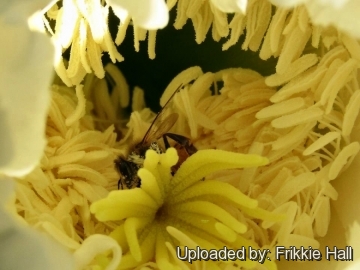 Trichocereus werdermannianus (Echinopsis werdermanniana) Photo by: Frikkie Hall
Trichocereus werdermannianus (Echinopsis werdermanniana) Photo by: Frikkie Hall Trichocereus werdermannianus (Echinopsis werdermanniana) Photo by: Frikkie Hall
Trichocereus werdermannianus (Echinopsis werdermanniana) Photo by: Frikkie Hall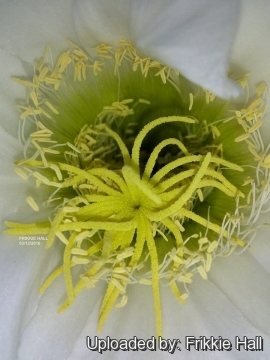 Trichocereus werdermannianus (Echinopsis werdermanniana) Photo by: Frikkie Hall
Trichocereus werdermannianus (Echinopsis werdermanniana) Photo by: Frikkie Hall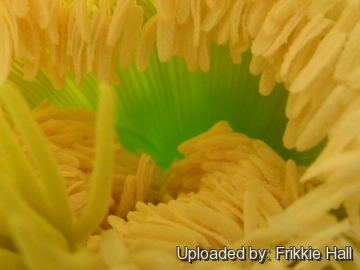 Trichocereus werdermannianus (Echinopsis werdermanniana) Photo by: Frikkie Hall
Trichocereus werdermannianus (Echinopsis werdermanniana) Photo by: Frikkie Hall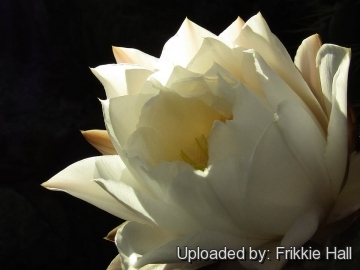 Trichocereus werdermannianus (Echinopsis werdermanniana) Photo by: Frikkie Hall
Trichocereus werdermannianus (Echinopsis werdermanniana) Photo by: Frikkie Hall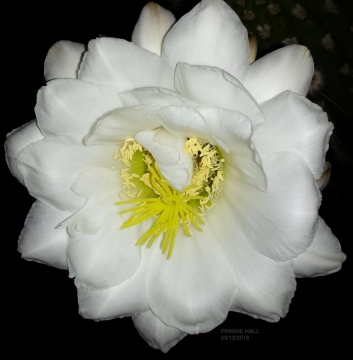 Trichocereus werdermannianus (Echinopsis werdermanniana) Photo by: Frikkie Hall
Trichocereus werdermannianus (Echinopsis werdermanniana) Photo by: Frikkie HallCultivation and Propagation: This is a a much decorative frost hardy cactus easily found in cultivation.
Soil: Grow it in a rich and particularly draining substratum, as it is very sensitive to rottenness when in presence of humidity and low temperatures and let the soil dry out between waterings.
Water: In summer, during the vegetative period, it must be regularly watered, but allowing the substratum to completely dry up before irrigating again; in winter, it’s to be kept dry. Preferable not to water on overcast days, humid days or cold winter days.
Hardiness: It is a very frost resistant cactus, hardy to -7°/-12° C. However in cultivation it is better not to expose it to temperatures lower than -5° C, even if in an aerated and protected location, in order to avoid the formation of anti-aesthetic spots on the epidermis. In presence of high atmospheric humidity avoid any frost as it is particularly sensitive to root rot.
Exposure: It need full sun exposures with ample airflow to produce dense hairs, but, as a former mountain dweller, does not care for extremely high temperatures in summer.
Maintenance: Repot in the spring, when their roots become cramped. Generally, they should be repotted every other year in order to provide fresh soil. After repotting, do not water for a week or more.
Use: Excellent as landscape or patio plant. It is suitable for “desert” gardens, in association with other xerophytes. Where the open air cultivation is not possible due to the climate, it is to be cultivated in pot in order to shelter it in winter.
Propagation: By seeds and by cuttings, provided left drying up well, in summer.
Your Photos

by Frikkie Hall



















